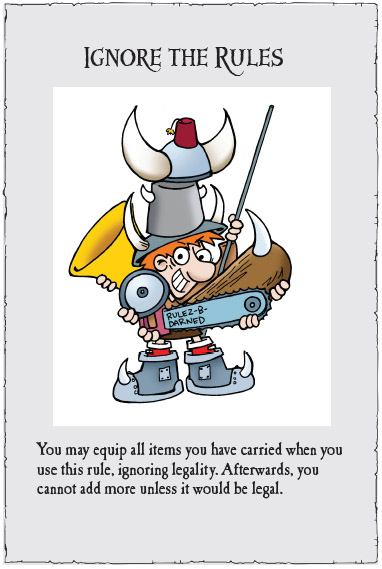MUNCHKIN AS
MONOMYTH
Jaym Gates
You’ll be famous, he said. You’ll be fabulously wealthy, he said. All the gorgeous princes will be asking you to the ball, he said. What a load of bollocks.
I mean, really. Look at this place. It’s a midden, not a dungeon. I’m pretty sure even rats have higher standards than this. But there’s me, wishing over the well one morning that I might have some sort of adventure, and next thing I know, some old guy with a posh accent and tatty robe is standing on the roof of my nice little house, using his staff as a lightning rod and proclaiming something about destiny. So, here we are, a bunch of bewildered strangers herded together by Sir Arsed, each of us tasked to find the Great Hoard of Immense Beauty, and not a one of us has the slightest bloody bit of interest in entering the dungeon. Who does this? Who looks at a filthy dungeon and says, “Oooo, guvnah, let’s have a stroll about and see if we can’t find some nice, quiet dragon, bash it about the head, and be home in time for tea? We can use the gold plate, today, I think.”
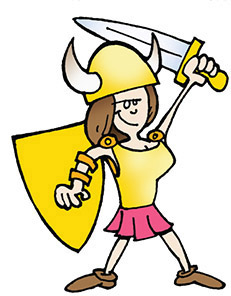
* * *
A few years ago, I had the chance to interview Jack Gladstone, a Native American elder from the Blackfoot tribe. I was writing about the tradition of oral storytelling in the modern age, and he agreed to speak with me about the subject by phone. He was driving through Montana at one point, and pulled off the road to stretch his legs, talking to me the whole time about how stories were the fabric of human experience. They were schools and churches and comfort on long, dark nights. But what I remember most is the experience of the interview. His voice wove a narrative that went beyond mere information, tapping into some emotional wellspring that is usually reserved for the best books or movies.
Sharing stories is, indeed, a primal experience. Even within a novel or short story, the author will often sit the characters around the fire for a ghost story, or have them tell stories while they travel. Think in particular of The Canterbury Tales, where the pilgrims spend most of the work telling one another stories. Done poorly, it’s a cheap tactic to shovel backstory or a moral into the tale. Done right, it’s a chance to give the reader an engaging experience that brings them into the characters’ world even more intimately.
As readers or listeners, we are constantly being engaged in what Joseph Campbell called “the hero’s journey,” in its most basic form – or, in more academic language, the monomyth. Campbell summarizes the idea in The Hero with a Thousand Faces: a hero ventures forth from the common world into a region of supernatural wonder; fabulous forces are there encountered and a decisive victory is won; the hero returns from this mysterious adventure with the power to bestow boons on his or her fellow man. These concepts aren’t limited to one time or culture; we are continually expanding, rewriting, evolving, and retelling the same basic stories that have always been told, putting our own cultural stamp on them before passing them on to the next generation to shape.
Even a short survey of many classic works – particularly in speculative fiction – shows a widespread adherence to Campbell’s model. Beowulf, The Odyssey, and even the original Star Wars trilogy all follow the pattern. That’s not to say Campbell’s is the only pattern, though. There are many dissenting voices that criticize his work as applicable only to a certain Western subset of stories, barring women and non-Western themes from the discussion. Charlie Jane Anders, in a piece for io9 titled “New Proof That Every Sci-Fi Epic Is Based On Joseph Campbell,” calls the monomyth “a cookie-cutter spiritual-ish adventure recipe,” while Film Crit Hulk explains on her website that her main problem with The Hero with a Thousand Faces is that “our society has overtly adopted the book’s breakdown of the hero journey as some kind of ready-made app for ‘paint by numbers’ storytelling.”
The beauty of the monomyth concept, however, is that it is absolutely malleable, and, as with anything, its power lies in what you do with it – particularly in gaming.
* * *
You know, in hindsight, when you’re thrust into a highly suspicious magical adventure, never allow yourself to be elected the scout.
I was just walking along, minding my own business, when WHAM! this screeching thing attaches itself to my head. And my weapon is a Big Rock. There are times when the solution hurts more than the problem. . . .
I don’t even want to be here. I didn’t know how hard it would be to step over that threshold into a dungeon that could hide anything from treasure to eldritch horrors. I used to love listening to the stories of Margian Godbane, Harran the Bold, and the great adventurer Encilia. As a kid, as just another farm girl in a remote part of this most minor of minor kingdoms, I whiled away the days, dreaming of traveling to the halls of elven kings and the depths of dwarven strongholds, fantasizing about bards writing of my bravery, and wallowing in the imagined glory of returning to my village as a household name.

Instead, I have a dead Psycho Squirrel attached to my head, and all I got out of the conflict was a Rat on a Stick. Never trust a Bard. Or a Wizard. They’re all in it together.
I wonder how my beloved Wizard would feel about a Large Angry Chicken in his bedroll tonight? I know I’d feel immensely better if that were to come to pass . . . even if he turns me into a frog.
* * *
To a creator of any sort, the monomyth offers a sort of loose recipe that brings together familiar ideas and processes for making a heroic tale that will speak to audiences and engage their emotions. But there’s more to using it than just following a preset list. The challenge for the creator is to sort out the ingredients she wants to use, making her own final concoction for her audience to enjoy.
And this is where Munchkin comes in: if you draw a handful of cards, there’s a story in them. All the pieces of the monomyth are there, too, but tossed into an unpredictable order in every game. It’s the monomyth in tasty, funny, bite-sized pieces – even if your personal choices in telling this story seems no more complex than deciding whether to loot the room or open another door, or choosing between the Cheese Grater of Peace and the Chainsaw of Bloody Dismemberment, and your journey through hell lacks the strange tangents of gods and sirens (usually – Munchkin is nothing if not surprising with the monsters).
Odysseus would have loved a Munchkin hero’s journey, come to think of it.
There’s more to it than that. Your fellow players are also influencing your story, taking the parts of antagonists and allies. Your struggle is against the game and against them, putting you directly in the shoes of the hero in a way that few other games do, and damn that player who adds 30 extra points to the Large Angry Chicken you’re about to kill to win the game.
Munchkin also shakes loose the focus on the character arc, and reminds the creator that the real power of a story is in its details. The basic plot exists to fulfill the character and offer impetus for her transformation, but it’s the details of that transformation that connect the audience to the story in the most meaningful ways.
* * *
It’s interesting how quickly you become blasé about monsters. We’ve been adventuring through this vile dungeon for days now, making camp in the safest rooms, kicking in doors, slaying monsters, triggering curses, looting corpses. It’s almost . . . enjoyable, in a sick way.
The monsters are getting bigger, and my weapons have gotten better. I’ve got a Swiss Army Polearm now, and it’s awesome. I can slice, bash, eviscerate, whip, open, screw, or clean the nails of just about any monster we find. My armor is incredible, too, if inexplicably jewel-encrusted.
And I even got a little dragon! He’s so cute, although he keeps crisping my locks. My companions finally made me cut my hair short. Something about how awful burned hair smells.
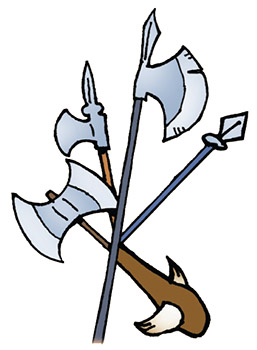
I kicked down a door today, though, and found out why the Wizard wanted us with him.
I always did want to be cannon fodder, truly I did.
* * *
As the comics character Charles Xavier, leader of the X-Men, says, “In mutant heaven, there are no pearly gates, but instead, revolving doors.” Death and resurrection are so common in pop culture franchises that they’re almost a running joke. Done too often, death and rebirth becomes cheap and shallow, robbed of all its pathos, drama, and emotional punch – the very antithesis of the role death is intended to play in the monomyth. Comics are particularly egregious in their abuse of the resurrection plot device. Mutant Jean Grey is constantly dying and coming back when needed. Instead of moments of growth, change, or evolution, these events become static points on a map, her passage unmourned by readers because they know it is only temporary. Hey, even when a character is only “on screen” for a few moments, his death should mean something to someone.
The same sort of criticism can be aimed at so-called Shakespearean deaths, with their drawn-out monologues and endless reprises. A good death scene is subtle and spare, or a short, hard punch. We all understand the emotions surrounding death, and with the right balance of information, a storyteller can tap the audience’s own experiences with death, in whatever form, to color in their scene, making it far more powerful than the most extended, violent, visceral demise.
Of course, sometimes a good death scene can be lightened with a little irony. You don’t want the scene to be funny, but gallows humor can go a long way toward keeping a dark story from becoming allconsumingly grim.
And when it comes to funny, look no further than Munchkin for an illustration.
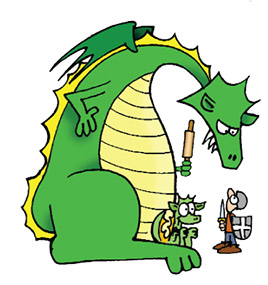
* * *
I don’t even know what the thing was. Unspeakably Awful Indescribable Horror, maybe, and apparently it really likes the taste of Warrior. I didn’t stand a chance. One moment it’s there. Next thing I know, it has wandered off and I’m lying on the floor, bleeding out, while everyone loots my gear. Seriously, these are my “companions” on this adventure?
* * *
The presence of death and rebirth in Munchkin speaks to the idea of character death – real or metaphorical – as a new beginning, something found in tales ranging from the epics about early Celtic gods to Mesopotamia’s Ishtar to King Arthur to Batman. In Munchkin, the deaths are funny, of course, but they’re also an opportunity for a player to take the reborn character on a vastly different path, to rip her feet out from under her and send her spinning in a new direction. True death – again, whether metaphorical or physical – should strip the character of everything that came before. Upon rebirth, their priorities, hopes, connections, even their way of thinking may be different.
This can be done as a reboot to a character who has lost hope or motivation, or to one who has become complacent in wealth, comfort, or privilege. It is one of the reasons we so often see stories beginning with the death of loved ones – it isn’t just the hero’s death that creates this precipitous change – and it all too often becomes a shorthand for emotional turmoil.
While this can be handled well, it’s a character-building device that must be used sparingly, and with care. Death is not the only way to push a character forward with haste and worry. Tolkien’s Bilbo had the weight of the world resting on him when he ran out his door without a handkerchief, but he didn’t know it yet, and a beautiful, powerful story was created without ever killing off the hero or his loved ones. Sometimes the threat of loss is greater than the actual loss, which is where the metaphorical death comes into play.
In Munchkin, you don’t really die. You just lose all of your stuff. But you are set back, weaker, vulnerable to even lower-class baddies and to your fellow players. It’s the same thing when a character suffers a world-changing event – amnesia, robbery, assault, the loss of home or loved ones – their defenses are gone, along with their carefully constructed habits of survival, and they are left shivering in the night while wolves howl around them.
Death, that king of chaos, is a great thing to inflict on characters or players who are becoming too complacent and safe with their piles of treasures and weapons, or their worldly knowledge. It shows that even the mightiest hero can be brought low. Physically, mentally, emotionally, death is transformative and wrenching, forcing the character to face her darkest self. When she comes back, she is remade, but that transformation can go many ways, from Batman’s dark, vengeful force, to Doctor Who’s erratic playfulness, to the pious, controlled peace of Zotoh Zhaan, of Farscape fame.
Whatever the result, the death and rebirth must be a pivotal moment for all involved – the hero, supporting characters, creator, and audience.
* * *
Wait, I’m alive? I know I was dead . . . I had this long talk with another old guy in a white robe, and he said something about me not being done with my journey. So, now I’m lying here, completely confused, and guess what? Still don’t have my stuff.
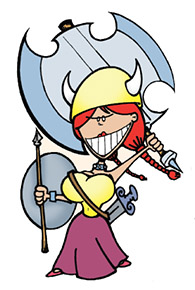
The party refused to give up the weapons and armor and other goodies they looted from me when I fell, so my dragon and spear are gone, but I got a tinfoil hat and an axe. They will have to do. I have a WHATSIT to slay and a treasure to claim.
If I make it out of here alive, may the gods smite me if I ever enter another dungeon or listen to another Wizard.
Hmmm. I wonder if the treasure includes any Wizard repellant?
* * *
The hero’s journey can last any length of time, from a few days to a lifetime. It can take many paths and many shapes, but in the end, the branching narratives line up to tell us one thing: it is human to quest, to look for a journey, to embark on that path and discover the best and worst of what we are, and what we can do. While life doesn’t usually include ducks in dungeons, I’ve met more than a few murderous potted plants, and there’s nothing funny about an overgrown asparagus fern next to the front door.
So next time you’re playing, take a closer look at those cards. There’s a whole lot of history behind them, a whole lot of storytelling magic, and it’s spelled out in the language of Maul Rats and Staffs of Napalm. 
Jaym Gates is an author, editor, and communications specialist. She has a lifelong horror of potted plants thanks to traumatic early experiences with an asparagus fern and would like to ask that the monster be reclassified as level 20. More information on the non-potted plant parts of her life and career can be found on her website jaymgates.com or Twitter @JaymGates.
